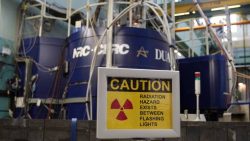Feds must act to protect nuclear workers’ pensions
By MATT WAYLAND, STEVEN SCHUMANN MAY. 23, 2018
If not, 3,400 workers will find themselves unable to contribute to their public service pension plans this fall.
Treasury Board President Scott Brison. The board has refused to say how much it would cost the government to continue to provide its nuclear workers with a public service pension plan, write Steven Schumann and Matt Wayland. The Hill Times photograph by Andrew Meade
This fall, 3,400 of Canada’s best and brightest nuclear workers will find themselves unable to contribute to their public service pension plans. In fact, any recently hired federal nuclear worker never even had the chance to do so. Hidden away in one of the previous government’s many omnibus budget bills was a provision that doomed them; a change that stripped them of their pension plans, so that the federal government could presumably save a few dollars.
The decision to strip Canada’s nuclear workers of their public service pension plans was taken in 2014. As part of a restructuring of Atomic Energy of Canada Limited (AECL), a Crown corporation of the federal government, the Harper government decided to implement a government-owned, contractor-operated (GoCo) model for the management of AECL’s nuclear laboratories.
The implementation of the GoCo model involved the creation of Canadian Nuclear Laboratories (CNL) as a subsidiary of AECL, with full responsibility for all day-to-day operations at AECL facilities. The second step involved transferring ownership of CNL from AECL to a private contractor. Under this model, all facilities managed by CNL remain owned by the federal government.
This restructuring has had a dramatic effect on the nuclear workers at these facilities. By implementing a GoCo model, the federal government forfeited control over its employees to a private contractor.
Starting in September 2015, existing employees of Canada’s nuclear facilities were given notice, without any real consultation, that they would no longer be able to contribute to their public service pension plans following a transitional period of three years. New employees were to be given no such coverage at all. This new arrangement even prevents CNL from creating a similar pension plan as provided under the Public Service Superannuation Act once the transition is complete. By excluding new hires from the transitional coverage entirely, the message to Canada’s federal nuclear workers is that any future alternative pension plan will not be equivalent, comparable, or negotiable.
Imagine being one of Canada’s highly skilled nuclear workers in this scenario? You may have made your choice to work for the federal government’s nuclear facilities in part because of the benefits you would receive. Now, stripped of one of the most important benefits—your public service pension plan—what’s your incentive to stay? Removing the ability to participate in the public service pension plan sends a clear message to nuclear professionals to look elsewhere for employment in a very competitive industry.
If the federal government is unwilling to provide a public service pension plan for these workers, how can we be sure that our country’s nuclear facilities continue to attract the best and the brightest in the field? How can our country’s nuclear industry retain the highly skilled professionals that are required to run these facilities if they cannot be certain about their retirement security? What does this tell us about how the government prioritizes the safety, security, and well-being of Canadian workers and the public, when it comes to our nuclear industry?
It is strange for the federal government to leave its employees out to dry since similar models in the United Kingdom have kept employees in their public plan. Since taking office in 2015, the Liberal government has pledged to support Canadian workers and growing the middle class. This is a clear example where this government could reverse a poorly made decision by the previous government and do just that.
But time is running out. As of September, all federal nuclear workers will be unable to participate in their public service pension plans. If this government is truly committed to helping Canadian workers, and growing the middle class, it will do the right thing and allow the employees of CNL to remain in the public service pension plan.
Unfortunately, despite our attempts to reach out to this government, officials have refused to take decisive action on this issue. We believe, based on our own cost-benefit analysis, that the benefits both to Canadian workers and to the federal government’s purse are positive, and that the government will save money by maintaining the public service pension plans of its nuclear workers. The Liberal government has provided no valid reason for refusing to take action, and the Treasury Board has refused to say how much it would actually cost the government to continue to provide its nuclear workers with a public service pension plan.
We know, however, that the long-term consequences to our nuclear industry will be dire if no action is taken to protect the pensions of our nuclear workers. Action must be taken now.
Steven Schumann and Matt Wayland are co-chairs of the Canadian Alliance of Nuclear Workers, which includes representatives from eleven unions, including the IAM, accounting for about 3,400 employees of Canadian Nuclear Laboratories (CNL).
The Hill Times




